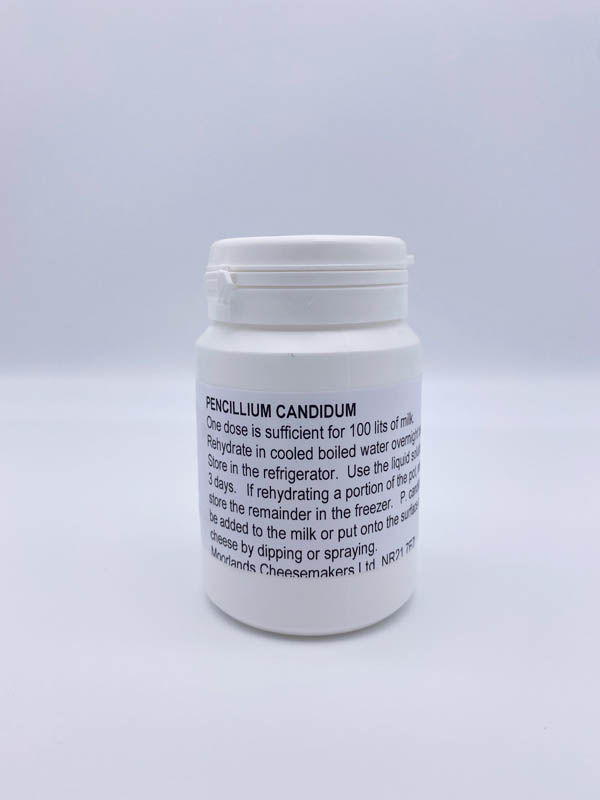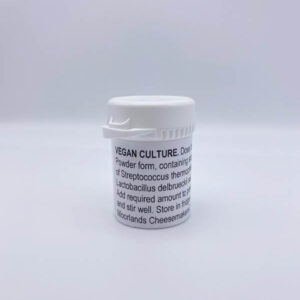Return To: Cheese Cultures
Penicillium Candidum Neige Culture
For making white mould ripened cheeses, such as Camembert or Brie. Pot contains sufficient for up to 200ltrs
For smaller batches. The very tip of a pointed knife, is sufficient when using 8ltrs of milk.
Rehydrate in cooled boiled water overnight before use. Store in refrigerator. Use the liquid solution within 3 days. If using a portion of the pot, reseal and store the remainder in the freezer. Penicillium Candidum Neige maybe be added to the milk or put onto the surface of the cheese by dipping or spraying. Wrap the cheese when a light covering of mould has grown, after about 9-10 days, but could be sooner if warmer. The cheese must be on a rack, in a high humidity atmosphere, at around 10c, for the coat to grow.
Store pot in freezer between batches.
£13.50
Description
Penicillium Candidum Neige Culture
Maybe used in one go with 100 litres of milk, or stored in the freezer between smaller batches of blue mould ripened cheese.
Cheese cultures are used to make and ripen cheese, yogurt and Kefir. Culture is also just another name for groups of beneficial bacteria, naturally living in raw milk. Penicillium Candidum Neige Culture is responsible for white, mould ripened cheeses.
Adult humans actually have trillions of friendly bacteria swimming around in their gut.
The definition of ‘Bacteria’. Small single-celled organisms, found almost everywhere on Earth and are vital to the planet’s ecosystems. Some species can live under extreme conditions of temperature and pressure.
Which brings me nicely onto the difference between Mesophilic and Thermophilic cultures.
When your cheese making recipe requires low-temperature preparation, a Mesophilic culture should be used. Works best with temperatures around 32c – 90f. Suitable for most soft and hard cheeses.
Thermophilic cultures, on the other hand, require heating the milk to higher temperatures. Usually above 32c – 90f. Cheese making recipes typically requiring a Thermophilic culture include Swiss cheese, Parmesan, Mozzarella …..
Therefore, these cultures are also essential helpers and control the milk fermentation during the cheese making process. Fermentation means these cultures acidify the milk, converting milk sugar (lactose) into lactic acid.
However, a cultures job doesn’t end with the initial fermentation process. They are also responsible for the way your cheese will taste at the end of the maturing or aging stage.
We stock a wide variety to suit the home and small scale cheese maker. Including white, blue and red mould producing cultures.
Recipes use the terms ‘Mesophilic’ and ‘Thermophilic’ therefore we have included this classification in our descriptions to make choosing the right culture easier.
Lastly, the worst thing that can happen is moisture gets into the pot and sticks the granules together. Seal pot tight before placing in the freezer between batches.
2 reviews for Penicillium Candidum Neige Culture
Only logged in customers who have purchased this product may leave a review.








Bex –
I ordered this culture along with a number of others and they arrived very promptly. I am so pleased to find a shop in the UK that sells cultures that do not arrive out of date and useless. I have been very pleased with the service and products bought from Moorlands.
This culture worked very well although I had never used it before. It does make the cheese look much nicer than if left ‘open’. It is also a bit of a bargain as one packet will last you ages!
Fiona and Brian –
We are into making bread, wine, beer, the usual jams and pickles, so cheese was the next obvious adventure. All form our flat in the East End of London. Loving it.